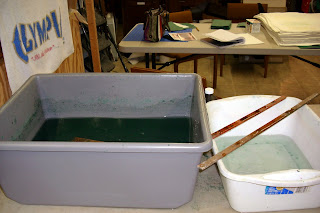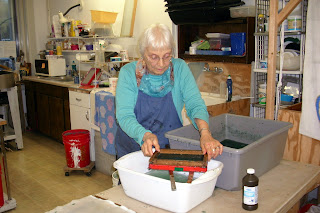I met Sara Gilfert, the art director of Paper Circle on Final Friday in April. And as I said before, that was my entry to the world of paper art. Sticking to my artistic pursuit, I requested her for an interview. During our conversation, Sara mentioned that they make the handmade paper used to create books, greetings, folders available in the studio. In fact, they hold workshops to teach how to make handmade paper.
When she said that, I couldn't believe my luck. I am a huge fan of handmade paper. The textures and hues of handmade paper give it a classy look. And I also like how we can see the colorful fibres in the paper. Handmade paper looks "earthy" and "close to nature." Also it is definitely environment friendly, when it is made from old clothes, waste paper etc.
So I almost instantaneously asked Sara if she would show me the process of making the handmade paper. Sara has been making paper for more than 30 years now. She is also a specialist in making Japanese paper and learnt the technique from a paper artist in Japan. She regulalry conducts workshops to teach how to make Japanese paper.
MinaTakahashi, the editor of Hand Papermaking magazine listed Paper Circle among one of the few facilities in the Midwest, where artists, who use advanced techniques and pulps, can work. The list was published in the global access guide in summer 2008 issue of the magazine.
When I requested Sara, she was making paper for folders for the graduation announcement of her grandchildren. She enthusiastically showed me the process of handmade papermaking;
how she turned dark green OU T-shirts into textured handmade paper.
That was an interesting transformation!

Beating
Sara told me she cut the green T-shirts in tiny pieces and put them into "Hollander Beater"- the machine that beats the mixture of cloth bits and water into pulp. This big machine gets its name from the country of its origin. The "bed-plate" in the machine can be adjusted to determine the texture and the tinkness of the pulp. The technique of beating (how hard and for how long) differs in western and oriental cultures, basically leading to variations in the thickness of the pulp.

Interesting tid-bits:
Sara said the machine hasn't really changed since the 1600, when it was introduced. The paper mills use similar machines, only bigger in size.
Traditionally, in western countries, paper was made from fabrics such as cotton and linen, that being the nature of clothing during earlier times. In eastern countries, hemp, mulberry branches were used to make paper. The branches of paper mulberry have to be "cooked" and "cooled" before the "beating" begins. Now ofcourse, wood is used to make paper in mills.
The next step was to mix enough water in the pulp so the mixture could be strained using a "mold and deckel." The Mold is like a sieve that is used to catch the paper fibers from the mixture of water and pulp. The deckle is a wooden frame, to keep the paper fibers from sliding off the mold.

Container with green pulp-water mixture
Sieving

Sara dunked the "mold and deckle" into the pulp-water mixture.
The "mold and deckle" have to be moved in such a way that the pulp settels on the screen evenly. The technique of moving the "mold and deckle" differs in the oriental and western traditions of papermaking.

Sara rested the 'mold and deckle" to get rid of excess water
 The fresh, green but "wet" paper :)
The fresh, green but "wet" paper :)
The wet paper landed on a bloating sheet.
Depending upon the size of the "mold and deckle," paper sheets of differnt sizes can be made

A stack of bloating sheets with wet green papers on each of the sheets
Pressing

This hydraulic press squeezes out the remaning water. The stack of bloating sheets went in it with a wooden plank at the bottom and on the top of the stack
Drying

There is a fan behind the stack, for drying up the paper completely. Another 24 hours may be!

From T-shirts to the handmade green paper
Thanks Sara! That was pretty amazing.
You can check the next work shop at Paper Circle @ http://www.papercircle.org/workshops.html



cool and interesting, ash~ I do not know how exactly a paper was made from even i am from the country where paper was invented.
ReplyDeleteVery cool, Ash! I remember having a handmade paper kit when I was a kid, but I only ever recycled old paper into new paper with it. How interesting to use a T-shirt!
ReplyDeleteThe transformation of the t-shirt into paper is amazing. I made a handmade paper birthday card last year just from newspaper. It was not too hard and is great fun to do at home. I learnt that because of all the dark ink newspaper turns very grey in the process. The next time I will use only white or colored paper -- or a t-shirt, now that I have specific and nicely illustrated instructions from you.
ReplyDeleteInterviewing Sara was great fun..I learned a lot in the process too. I am going to take a stab at it in summer..or may be even join a workshop! How cool would that be?
ReplyDelete